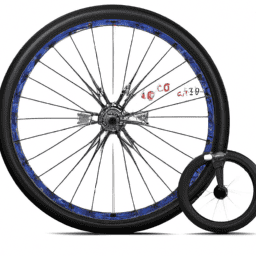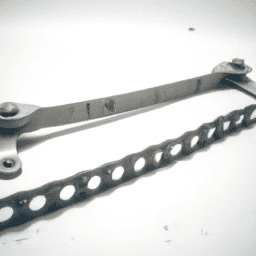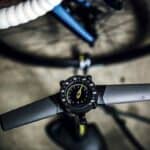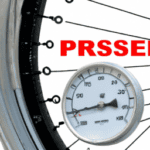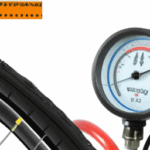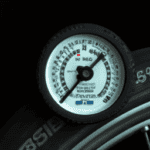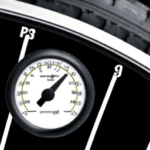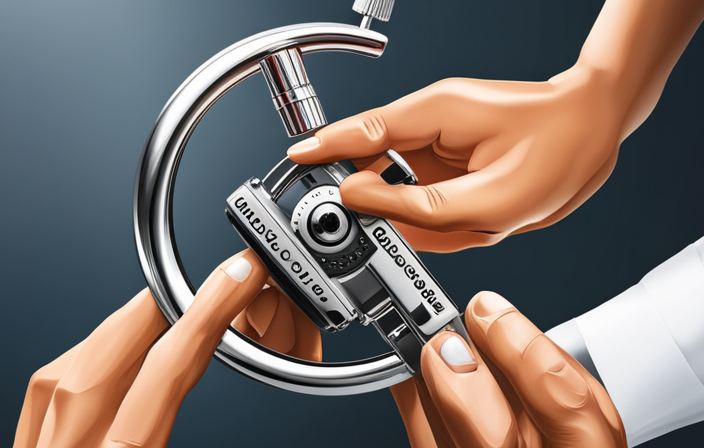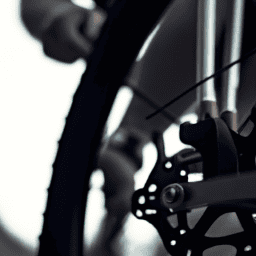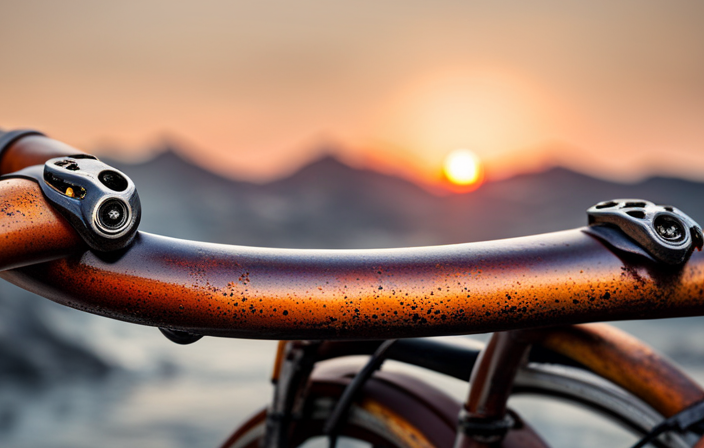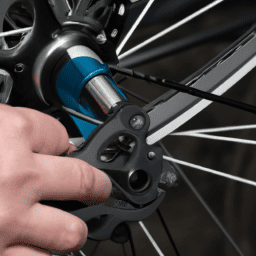Ever wonder about the perfect air pressure for your bike’s tires? Getting it just right makes for a silky, secure journey. It touches everything from how your bike zips around to how it feels under you. If you’re zipping down highways on a road bike or tackling trails on a mountain bike, getting a grip on tire pressure essentials could boost your biking big time.
First off, let’s clear up some confusion about tire pressure. The recommended pressure varies depending on your bike, tire size, weight, and riding conditions. It’s not a one-size-fits-all solution. However, there are some general guidelines that you can follow to ensure you have the correct tire pressure.
In this article, we’ll explore those guidelines and provide tips for maintaining proper tire pressure. So, get ready to learn everything you need to know about keeping your bike’s tires inflated to the right pressure.
Key Takeaways
- Maintaining correct tire pressure is crucial for safe and smooth bike rides.
- Recommended pressure varies based on bike, tire size, weight, and riding conditions.
- Properly inflated road bike tires range from 80-130 psi and mountain bike tires range from 30-50 psi.
- Adjust tire pressure based on terrain, riding style, weight, and comfort, as small changes in pressure can greatly affect ride quality and performance.
Understanding Tire Pressure Basics
You may be wondering what the optimal tire pressure is for your bike, but understanding the basics of tire pressure will help you avoid any potential mishaps on the road. The importance of inflation cannot be overstated as it affects your bike’s handling, comfort, and safety.
If your tires are underinflated, they’ll feel sluggish, and you’ll have to work harder to keep your bike moving. On the other hand, overinflated tires will make your bike feel stiff, and you’ll lose traction, especially on wet or slippery surfaces.
Another factor that affects tire pressure is temperature. During cold weather, tire pressure drops because the air molecules inside the tire contract. Conversely, during hot weather, tire pressure increases because the air molecules expand. Therefore, it’s crucial to check your tire pressure regularly and adjust it accordingly.
With these factors in mind, let’s now move on to the guidelines for road bikes, which will help you determine the optimal tire pressure for your bike.
Guidelines for Road Bikes
Properly inflated road bike tires are essential for a smooth and safe ride, ensuring optimal performance and comfort. As a beginner, you may be wondering what the ideal tire pressure for your road bike should be. The answer depends on various factors such as your weight, the type of road surface, and the tire width.
Generally, road bike tire pressure ranges from 80-130 psi (pounds per square inch). As a rule of thumb, it’s recommended to inflate your tires to the maximum pressure listed on the sidewall of the tire.
However, this may not always be the most suitable option for everyone. To find the ideal pressure for your bike, start by inflating the tire to the maximum pressure and then gradually decrease the pressure until you feel comfortable riding.
Additionally, it’s vital to check your tire pressure before every ride, and particularly on long rides, as tire pressure can decrease over time due to temperature changes or small punctures.
By maintaining the correct tire pressure, you can achieve a smooth and safe ride while reducing the risk of punctures.
Now that you know the basics of bike tire pressure for beginners and tips for maintaining tire pressure on long rides, let’s move on to the guidelines for mountain bikes.
Guidelines for Mountain Bikes
As a mountain biker, it’s important to know the recommended tire pressure range for your bike. This range can vary depending on factors such as your weight, terrain, and riding style.
Adjusting your tire pressure based on the terrain and riding style can make a significant difference in the performance and safety of your ride.
Remember to always prioritize your safety and adjust your tire pressure accordingly.
Recommended Tire Pressure Range
When cycling on rough terrain, it’s important to maintain tire pressure within the recommended range to ensure a smooth ride. Consistency in tire pressure is key, as fluctuations in pressure can significantly affect your ride quality. Additionally, temperature can also impact tire pressure, with warmer temperatures causing the air inside the tire to expand and increase pressure.
To ensure you’re within the recommended range, check the sidewall of your tire for the manufacturer’s suggested PSI (pounds per square inch). Generally, mountain bike tire pressure ranges from 30-50 PSI, but this can vary depending on the type of terrain you’ll be riding on.
Here are a few tips to keep in mind when adjusting your tire pressure:
-
Lower pressure provides better traction on rough terrain, but may increase the risk of pinch flats or damage to the tire.
-
Higher pressure provides better efficiency on smoother terrain, but may result in less traction and a rougher ride on rough terrain.
-
Adjust pressure based on your weight and riding style, with heavier riders typically requiring higher pressure to prevent tire damage.
-
Always carry a pump or CO2 inflator with you on rides to make quick pressure adjustments as needed.
When adjusting pressure based on terrain and riding style, keep in mind that small changes can make a big difference. Experiment with different pressures to find what works best for you and your bike.
Adjusting Pressure Based on Terrain and Riding Style
Experimenting with various tire pressures can bring about a noticeable difference in ride quality and performance based on the type of terrain and riding style. Choosing the appropriate tire pressure for your bike can help you achieve the best performance and comfort while riding. For instance, if you plan on riding on rough terrains such as off-road trails or rocky paths, you may want to consider reducing your tire pressure to improve traction and stability. On the other hand, if you’re riding on smooth pavement, increasing the tire pressure can help reduce rolling resistance and improve speed.
Proper posture and choosing appropriate gear can also affect your riding experience. Maintaining an upright posture and wearing the right clothing can help reduce drag and increase efficiency. Additionally, ensuring that your bike is well-maintained, including having the right tire pressure, can help prolong the lifespan of your bike and avoid any unnecessary accidents. In the next section, we’ll discuss some tips for maintaining proper tire pressure and ensuring optimal performance.
Tips for Maintaining Proper Tire Pressure
As a cyclist, it’s crucial to maintain proper tire pressure for optimal performance and safety. To achieve this, you should check tire pressure regularly, using a pressure gauge to ensure accuracy.
You should also be aware of how to inflate or deflate your tires to meet your bike’s specific needs. Proper tire pressure can make all the difference in your cycling experience, so it’s important to take the time to maintain it properly.
Checking Pressure Regularly
Don’t forget to regularly check your bicycle tire pressure to ensure a smooth and safe ride. Proper inflation is crucial for maintaining control and stability while riding. Here are a few things to keep in mind when checking your tire pressure:
-
Importance of inflation: Maintaining proper tire pressure ensures that your bike is able to handle the weight of both you and the bike and provides sufficient traction on the road, especially during turns. Underinflation can lead to poor handling, reduced speed, and an increased risk of flats.
-
Signs of underinflation: If your tires appear flat or have noticeable bulges, this is a clear sign of underinflation. Another way to check is to press down on the center of the tire with your thumb. If it feels soft and spongy, it’s time to add air.
-
Checking frequency: It’s recommended to check your tire pressure at least once a week, or before each ride if possible. This ensures that you catch any issues early on and can address them before they become bigger problems.
Now that you know the importance of proper tire pressure and how to spot underinflation, it’s time to learn how to use a pressure gauge to get an accurate reading.
Using a Pressure Gauge
It’s essential to get an accurate reading of the air level in your tires to ensure a smooth ride, and that’s where using a gauge comes in handy. With accuracy concerns in mind, using a pressure gauge ensures that you have a precise measurement of the air pressure in your tires.
It’s important to keep in mind that there are different types of gauges available, including digital and analog gauges. Digital gauges are typically more accurate and user-friendly, while analog gauges are more traditional and may require more skill to use.
When using a pressure gauge, make sure to follow the manufacturer’s instructions carefully. Place the gauge onto the valve stem and press down firmly to get a reading. If you’re unsure of the correct pressure level, refer to the sidewall of your tire or consult a professional.
Once you have an accurate reading, you can adjust the air pressure in your tires accordingly. This will be discussed in the subsequent section about inflating and deflating tires.
Inflating and Deflating Tires
To keep your ride smooth and comfortable, make sure you know how to properly inflate and deflate your tires. Proper tire maintenance is essential to ensure safety on the road, and the first step towards achieving this is by maintaining the ideal tire pressure. Here are some essential tips to keep in mind when inflating and deflating your tires:
-
Use a reliable pressure gauge to check your tire pressure regularly. This will help you maintain the correct tire pressure and avoid underinflated or overinflated tires.
-
Don’t rely on visual inspection alone to determine the tire pressure. A tire can look fully inflated even when it’s underinflated, and vice versa.
-
Always follow the manufacturer’s recommended tire pressure. This information is typically found in the owner’s manual or on a sticker placed on the door jamb or in the glove compartment.
-
Inflate or deflate your tires only when they’re cold, as heat can cause the pressure to increase and give you a false reading.
-
Avoid common mistakes in tire pressure management, such as inflating or deflating your tires based on the outside temperature or filling them up to the maximum pressure listed on the sidewall.
By following these tips, you can ensure that your tires are properly inflated and maintain the ideal tire pressure. Remember that proper tire maintenance isn’t only crucial for your safety but can also extend the life of your tires and improve your fuel efficiency.
Frequently Asked Questions
How does temperature affect tire pressure on a bicycle?
Oh boy, you’re in for a treat! Did you know that temperature can have a major impact on your bicycle’s tire pressure? Not only can it affect your performance, but it also requires some safety precautions. Keep an eye on those tires!
Can I use the same tire pressure for both my front and rear tires?
You should not use the same tire pressure for your front and rear tires. The ideal range varies based on weight distribution. Front tires typically require more pressure than rear tires due to weight distribution impact.
Is it better to have higher or lower tire pressure for off-road cycling?
For off-road cycling, it’s better to have lower tire pressure for improved traction and shock absorption. This can enhance performance on rough terrain. However, there are also cons to low pressure, such as increased risk of flats and slower speed on smooth surfaces.
How often should I check my bicycle tire pressure?
Like a beating heart, regularly check your tire pressure for safety and performance. Proper inflation is paramount. Use a gauge and follow manufacturer recommendations. Tips for maintaining tire pressure include avoiding sharp objects and keeping valves clean.
What are the consequences of riding with incorrect tire pressure?
Riding with incorrect tire pressure can negatively affect performance and safety. Low pressure causes increased rolling resistance and instability, while high pressure results in less traction and a harsher ride. Regularly check tire pressure for optimal performance and safety.
Conclusion
Congratulations! You now have a better understanding of the importance of proper tire pressure for your bike. Remember, maintaining the correct tire pressure is crucial for a safe and smooth ride.
Whether you’re a road biker or a mountain biker, always adhere to the recommended tire pressure guidelines to ensure maximum performance. Did you know that a 10% decrease in tire pressure can result in a 15% increase in rolling resistance? This means that maintaining the correct tire pressure can significantly improve your bike’s efficiency.
Additionally, proper tire pressure can also increase the lifespan of your tires, reduce the risk of flats, and improve traction and handling on the road or trail. Don’t forget to regularly check and adjust your tire pressure as needed. Invest in a quality tire pressure gauge and keep it with you on your rides.
By following these guidelines and tips, you’ll be sure to have a safer and more enjoyable biking experience. Happy riding!
